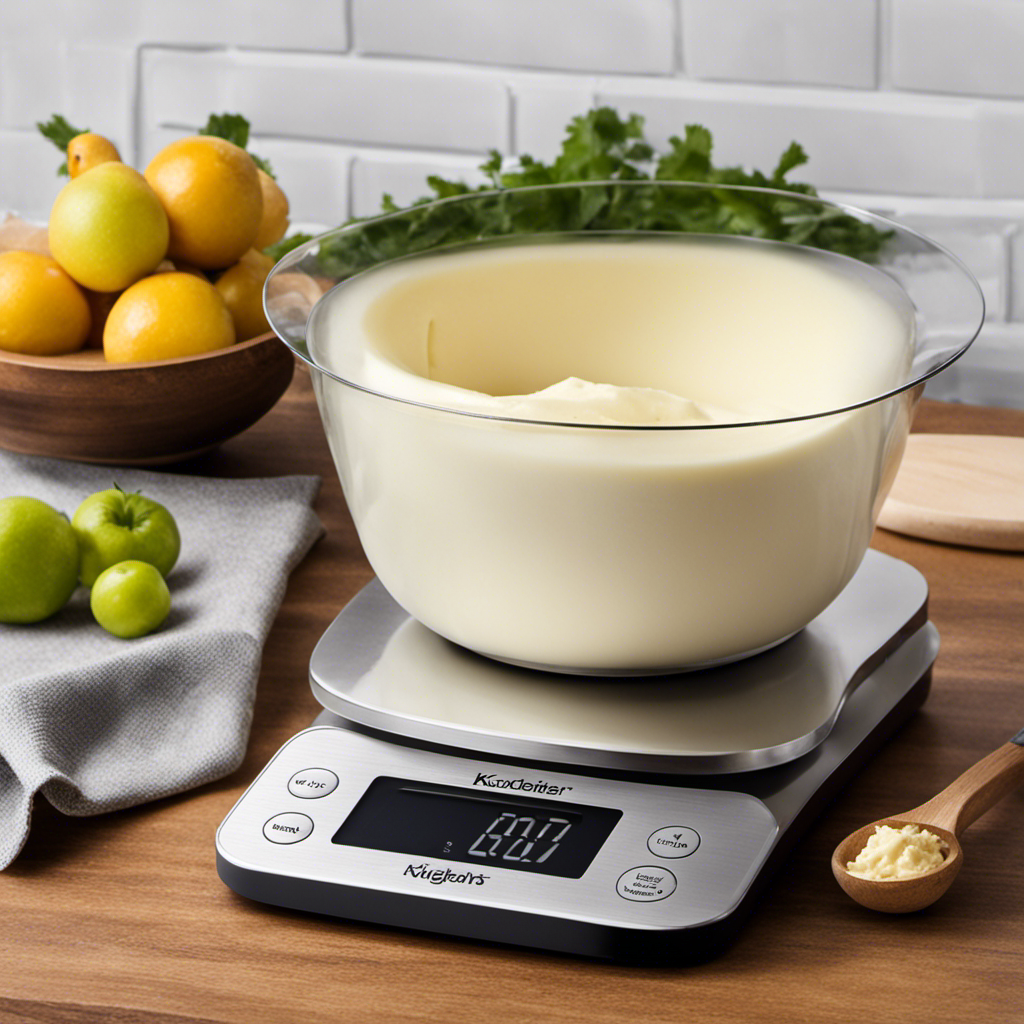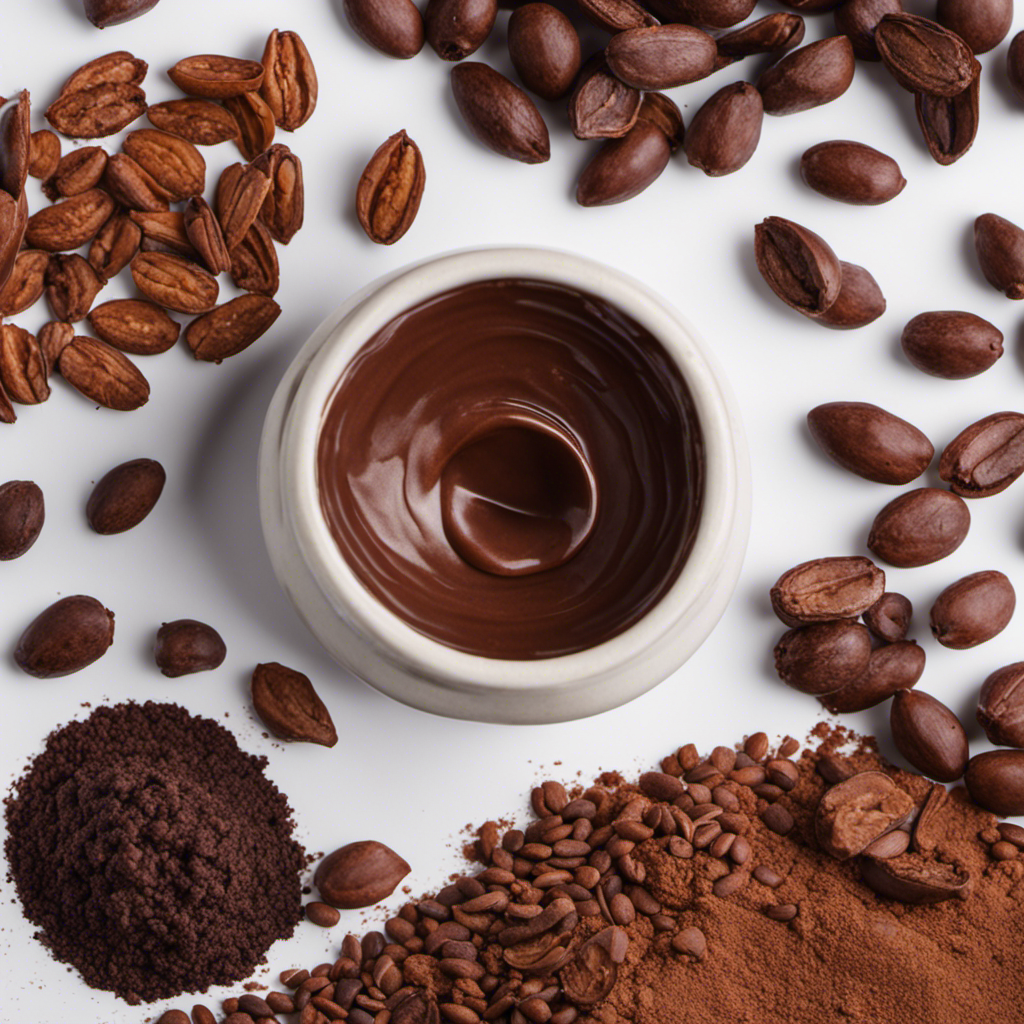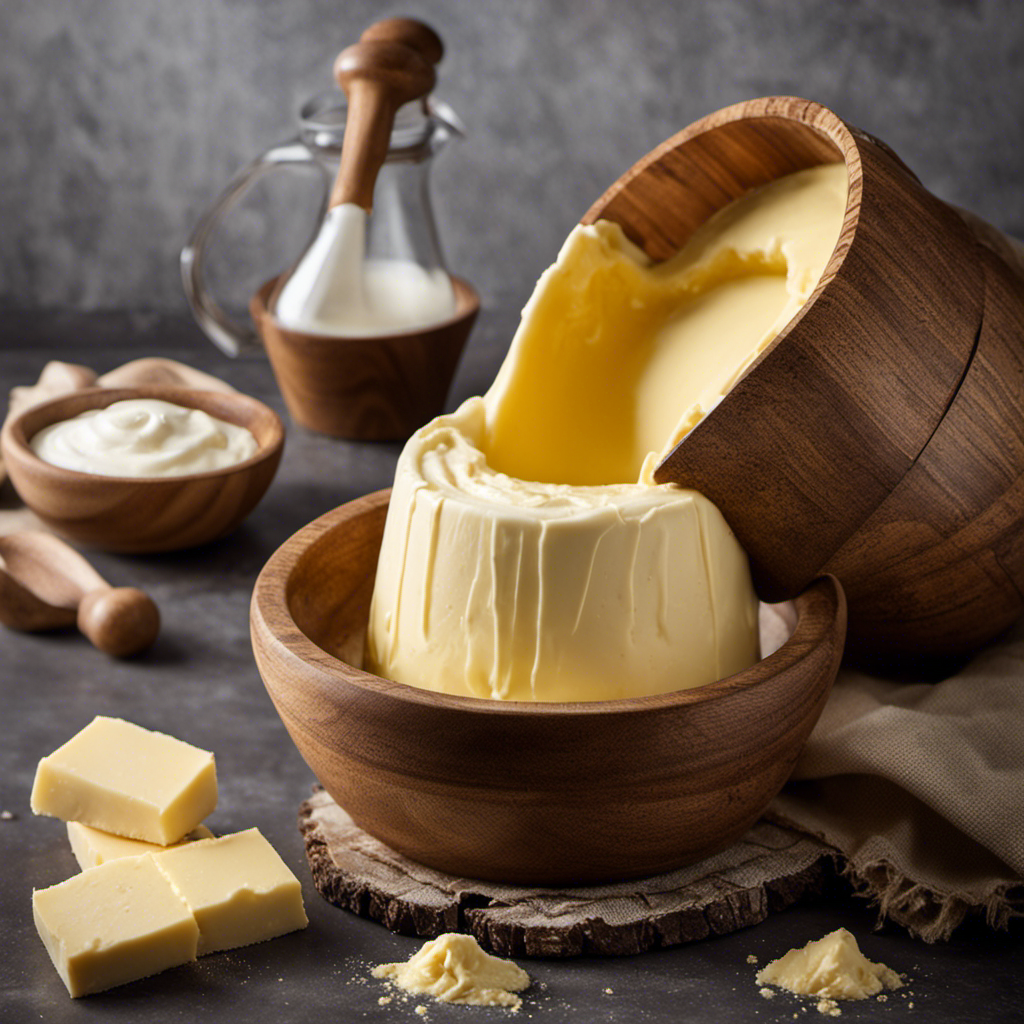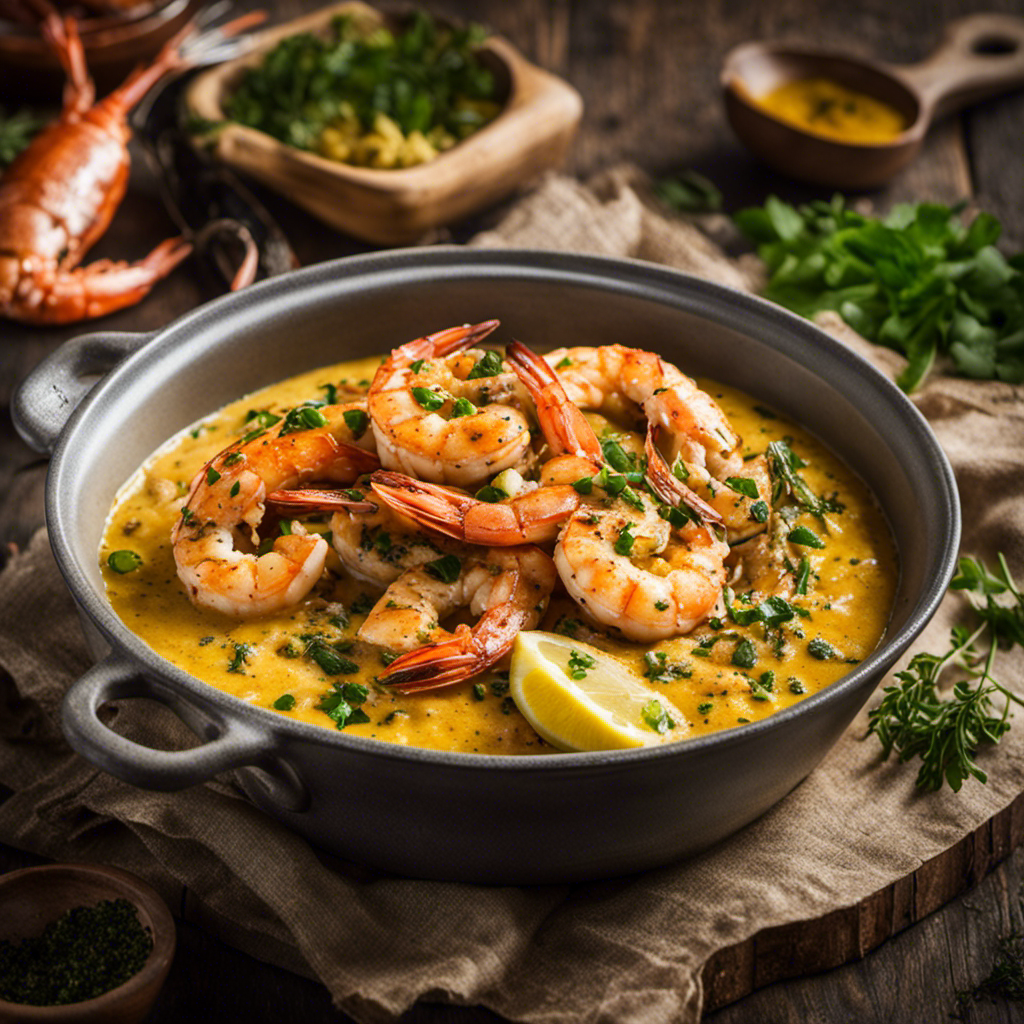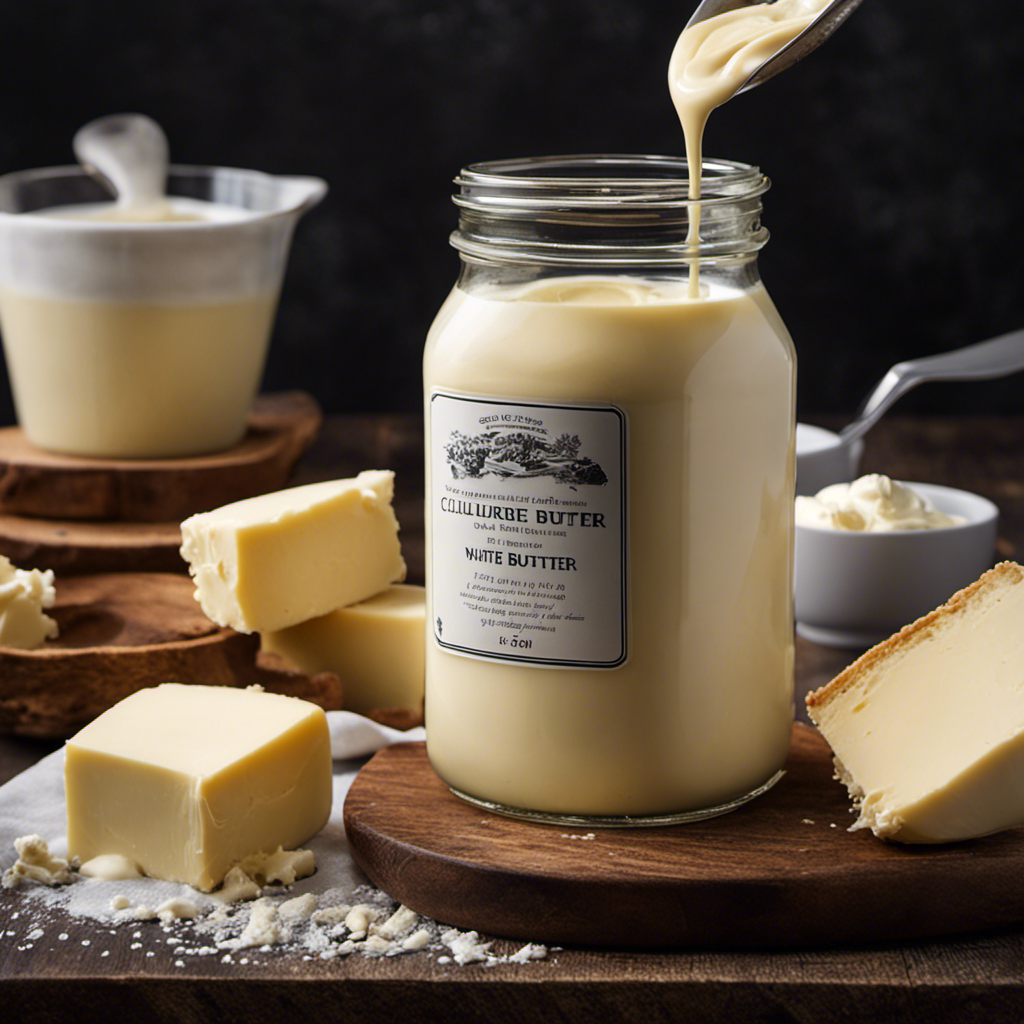Butter Tips and Tricks
How Many Tablespoons in 2/3 Cup of Butter?
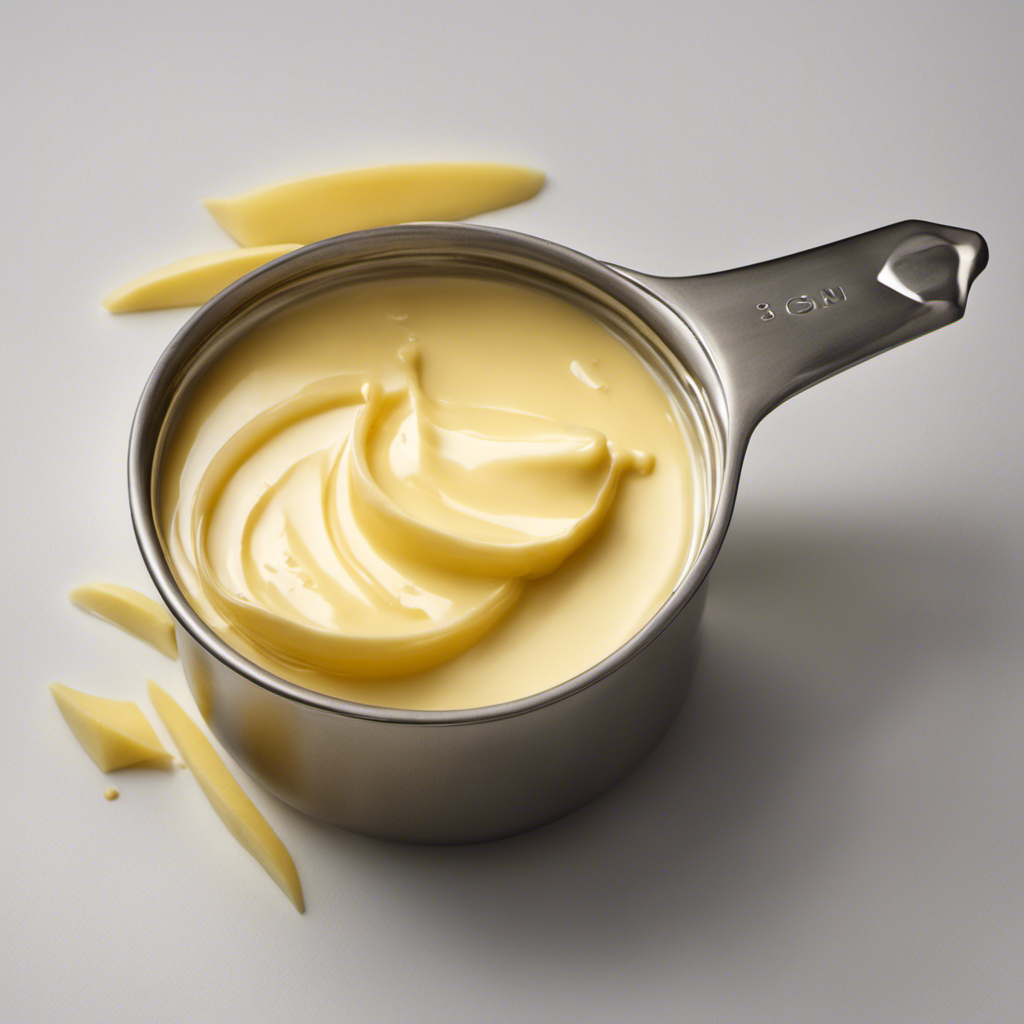
I’ve always been curious about the number of tablespoons contained in 2/3 cup of butter. It seems like a minor detail, but it can significantly impact the outcome of a recipe. Thus, I took it upon myself to conduct some research and definitively determine the answer.
In this article, I’ll share with you the conversion ratio, tips for measuring butter accurately, and even how to adjust recipes with different butter measurements.
Get ready to become a butter conversion expert!
Key Takeaways
- There are 16 tablespoons in 1 cup of butter.
- To convert cups to tablespoons, multiply the number of cups by 16.
- Accurate measurements are essential for recipe success, especially in baking.
- Tips for measuring butter accurately include using a kitchen scale, reading measurement markings, using a butter dish, and packing butter tightly in a measuring cup.
Understanding the Conversion Ratio
To understand the conversion ratio, you need to know that there are 16 tablespoons in 1 cup of butter. When it comes to converting butter measurements, this ratio is crucial. It allows you to easily determine how many tablespoons are in a given amount of butter.
Let’s say you have half a cup of butter and want to know how many tablespoons that is. You simply multiply the number of cups (0.5) by the conversion ratio (16). So, 0.5 x 16 = 8 tablespoons.
Understanding butter ratios like this can be incredibly helpful in the kitchen. Whether you’re following a recipe or trying to adjust measurements, knowing the conversion ratio makes it easier to work with butter and ensure your dishes turn out just right.
Converting Cups to Tablespoons
There’s a quick way to convert cups into tablespoons. When it comes to measuring butter accurately, understanding conversion ratios is key.
To convert cups to tablespoons, you need to know that there are 16 tablespoons in 1 cup. This means that for every cup of butter, you have 16 tablespoons.
So, if a recipe calls for 1/2 cup of butter, you can easily calculate that it is equal to 8 tablespoons. This conversion is useful when you want to measure out butter in smaller increments, such as when making cookies or frosting.
The Importance of Accurate Measurements
Accurate measurements are essential for ensuring the success of your recipes. When it comes to baking, precision is key. Here are some tips for measuring butter accurately:
- Use a kitchen scale: Weighing the butter will give you the most accurate measurement.
- Read the measurement markings: Many butter sticks have measurements marked on the wrapper, making it easy to cut the right amount.
- Use a butter dish: If you don’t have a scale or marked wrapper, use a butter dish with measurements to get the perfect amount.
- Use a measuring cup: If you only have a measuring cup, make sure to pack the butter tightly to get an accurate measurement.
It’s important to measure butter accurately because it can greatly affect the texture and consistency of your baked goods.
Now, let’s dive into calculating butter in tablespoons.
Calculating Butter in Tablespoons
Using tablespoons is a convenient way to measure butter for recipes. When converting butter measurements accurately, it’s important to know the common butter measurements for baking.
One stick of butter is equal to 8 tablespoons. This is a common measurement used in many recipes. However, if you need a smaller amount, you can easily measure half a stick of butter, which is equivalent to 4 tablespoons. For larger quantities, two sticks of butter is equal to 1 cup, or 16 tablespoons.
It’s crucial to accurately measure butter in recipes because it affects the texture and taste of your baked goods. So next time you’re in the kitchen, remember these common butter measurements to ensure your recipes come out perfectly every time.
Tips for Measuring Butter
When measuring butter, make sure to take into account the markings on the wrapper. These markings typically indicate tablespoons, making it easier to measure accurately without a scale.
Here are some tips for measuring butter without a scale:
-
Soften the butter: Before measuring, let the butter soften at room temperature. This will make it easier to scoop and measure accurately.
-
Use a tablespoon: If the butter is in stick form, cut off the desired amount using a tablespoon. The markings on the wrapper can guide you.
-
Pack it into a measuring cup: If the butter is in a tub, scoop it into a measuring cup, making sure to pack it firmly. Use a knife to level off the top.
-
Use water displacement: If you don’t have a measuring cup or tablespoon, you can use the water displacement method. Fill a glass measuring cup with water, then add the butter until the water level rises to the desired measurement.
Converting Other Measurements to Tablespoons
To convert other measurements to tablespoons, simply refer to a conversion chart or use an online conversion tool. Converting ounces to tablespoons is a common task in the kitchen. For example, if a recipe calls for 4 ounces of a liquid ingredient, you can easily convert that to tablespoons by multiplying the number of ounces by 2. So, 4 ounces would be equal to 8 tablespoons.
Similarly, when converting grams to tablespoons, it’s important to know the density of the ingredient. For liquids, the conversion is usually 1 gram to 0.067 tablespoons, while for dry ingredients, it varies depending on the density. By using conversion charts or online tools, you can quickly and accurately convert any measurement to tablespoons.
Speaking of measurements, let’s move on to discussing common baking measurements.
Common Baking Measurements
Baking recipes often require precise measurements of ingredients, which can be achieved by using a kitchen scale. When it comes to butter, converting the measurements for different types of desserts can be tricky.
Here are some tips to help you navigate the world of butter measurements:
-
Understanding the difference between salted and unsalted butter is crucial. Salted butter contains added salt, while unsalted butter does not. It’s important to use the right type of butter based on the recipe’s instructions.
-
Converting butter measurements from cups to tablespoons can be done by keeping in mind that 1 cup of butter is equal to 16 tablespoons. This conversion is handy when a recipe calls for a specific amount of tablespoons.
-
Remember that butter is often measured in tablespoons for easy and accurate portioning. Using a kitchen scale can also help ensure precise measurements.
-
Experimenting with different types of butter, such as flavored or cultured butter, can add an extra layer of flavor to your desserts. Just keep in mind that the measurements may vary.
Understanding these nuances will not only make your baking experience more enjoyable but also ensure that your desserts turn out delicious every time.
Happy baking!
Using a Kitchen Scale for Precision
Now that we’ve covered common baking measurements, let’s talk about the benefits of using a kitchen scale for precision.
While measuring cups and spoons are commonly used in the kitchen, they may not always provide the most accurate results. That’s where a kitchen scale comes in handy.
Using a kitchen scale allows you to measure ingredients by weight rather than volume. This is particularly important when it comes to measuring butter, as it can be difficult to accurately convert between tablespoons and cups. With a kitchen scale, you can simply place your bowl on the scale, zero it out, and then add the desired amount of butter in grams or ounces.
Not only does using a kitchen scale provide more accurate measurements, but it also ensures consistency in your recipes. So the next time you’re baking and need to measure butter, consider using a kitchen scale for precise and reliable results.
Adjusting Recipes With Different Butter Measurements
When it comes to baking and cooking, butter is a staple ingredient. It adds flavor, richness, and moisture to our favorite dishes. However, sometimes recipes call for different measurements of butter. Whether it’s in cups, tablespoons, or grams, it can be confusing.
In this discussion, I will share some helpful butter conversion tips. I will explain how to make recipe measurement adjustments based on the amount of butter you have on hand. Additionally, I will provide a few butter substitution options for those looking to experiment with different ingredients.
Butter Conversion Tips
Did you know that a cup of butter is equivalent to 16 tablespoons? That’s a lot of butter! When it comes to baking and cooking, it’s important to know the measurements and conversions for butter. Here are some helpful tips to make sure you’re using the right amount of butter in your recipes:
-
Use a measuring cup: A cup of butter is equal to 2 sticks or 16 tablespoons. Measure it accurately to ensure the perfect balance of flavors.
-
Best butter brands: Look for trusted brands like Land O’Lakes, Kerrygold, and Plugra. These brands are known for their high-quality butter that adds rich flavor to your dishes.
-
Soften butter properly: When a recipe calls for softened butter, it means the butter should be at room temperature. Leave it out for about 30 minutes before using to achieve the best consistency.
-
Substitute with caution: If you run out of butter, you can use alternatives like margarine or coconut oil. Just be aware that they may slightly affect the taste and texture of your dish.
Knowing these butter measurement equivalents and using the best butter brands will help you create delicious and perfectly balanced recipes every time. So go ahead, grab that cup of butter and get cooking!
Recipe Measurement Adjustments
If you’re adjusting a recipe’s measurements, remember to consider the different amounts of ingredients needed for the desired serving size.
One important aspect to consider is the butter to oil substitution, especially when converting butter measurements for savory dishes.
When substituting butter with oil, keep in mind that one cup of butter is equivalent to 16 tablespoons. So, if your recipe calls for 1/2 cup of butter, you would need 8 tablespoons of oil instead.
It’s crucial to note that butter and oil have different properties, so the substitution may slightly alter the texture and taste of the dish. However, this conversion allows you to make the necessary adjustments while still achieving a delicious and satisfying result.
Butter Substitution Options
To substitute butter in your recipes, consider using alternative options like margarine or coconut oil for a healthier twist. These butter substitutes can provide a similar texture and flavor to your dishes while offering potential health benefits.
Here are some options to consider:
-
Margarine: This spreadable butter substitute is made from vegetable oils and contains less saturated fat than butter. Look for options that are trans fat-free and made with healthy oils like olive or avocado oil.
-
Coconut oil: Known for its unique flavor and health benefits, coconut oil can be a great substitute for butter. It adds a subtle hint of coconut flavor to your recipes and works well in both sweet and savory dishes.
-
Olive oil: Another healthy alternative to butter is olive oil. It is rich in monounsaturated fats, which can help improve heart health. Use it in baking or cooking to add a light, fruity flavor to your dishes.
-
Ghee: Ghee is a form of clarified butter that has been used in Indian cuisine for centuries. It has a rich, nutty flavor and a higher smoke point than regular butter, making it ideal for sautéing and frying.
When substituting butter, it’s important to consider the flavor profile of your recipe. To enhance the buttery taste, you can add a touch of butter flavor enhancers like vanilla extract or butter extract. These can help mimic the taste of butter without actually using it.
Experiment with different substitutes and flavor enhancers to find the perfect combination for your dishes.
How to Measure Butter Without a Scale
When it comes to baking, butter is a crucial ingredient that needs to be measured accurately. In this discussion, I will be exploring three key points related to measuring butter.
Firstly, we will discuss butter portion conversions. Whether you’re trying to convert butter from cups to tablespoons or vice versa, it’s important to understand the ratios. This knowledge will help you adjust your recipes accordingly and ensure the right amount of butter is used.
Next, we will explore alternative measuring methods for butter. Not everyone has a kitchen scale, but that shouldn’t stop you from baking delicious treats. I will share some handy tricks and techniques that can be used to measure butter without a scale. These methods can be especially helpful in a pinch or when you’re in a hurry.
Lastly, we will delve into common butter measurements. Understanding the standard measurements for butter, such as sticks, tablespoons, and grams, will make it easier for you to follow recipes accurately. I will provide a comprehensive guide to these measurements, so you can confidently measure butter for any recipe.
Whether you’re trying to convert butter from cups to tablespoons or looking for alternative ways to measure butter without a scale, this discussion will provide you with valuable information. By understanding butter portion conversions, alternative measuring methods, and common butter measurements, you can ensure your recipes turn out perfectly every time. So let’s dive in and discover the world of butter measurement!
Butter Portion Conversions
The cup of butter equals how many tablespoons? It’s a question that comes up often when following a recipe. To help you navigate the world of butter measurement equivalents and portion sizes, here are some handy tips:
-
1 cup of butter is equal to 16 tablespoons.
-
A tablespoon of butter is typically around 14 grams or 1/2 an ounce.
-
When using butter, it’s important to consider portion sizes. For baking, a tablespoon of butter is usually sufficient. However, for spreads or sauces, you may need to increase the amount.
Knowing these butter measurement equivalents and portion size suggestions can make a big difference in your cooking and baking endeavors. So, next time you’re in the kitchen, you’ll have the knowledge to measure and portion out your butter accurately.
Happy cooking!
Alternative Measuring Methods
If you’re looking for alternative measuring methods, consider using a kitchen scale to accurately measure your ingredients. While traditional measuring cups and spoons are commonly used in the kitchen, there are other creative measuring techniques you can try. One option is to use a kitchen scale to measure butter. This can be particularly useful when a recipe calls for butter in tablespoons but you only have a stick of butter on hand. By weighing the butter on a kitchen scale, you can easily convert the measurement to tablespoons using a simple conversion table. Here’s an example of a conversion table for butter measurement alternatives:
| Butter (in grams) | Butter (in tablespoons) |
|---|---|
| 30g | 2 tbsp |
| 60g | 4 tbsp |
| 90g | 6 tbsp |
| 120g | 8 tbsp |
Common Butter Measurements
As I mentioned earlier, there are alternative measuring methods for butter. However, it’s important to have a solid understanding of butter density to accurately convert butter measurements for international recipes. Here are a few things to keep in mind:
- Butter density can vary depending on factors such as temperature and brand.
- In the United States, butter is typically measured in cups, tablespoons, and sticks.
- European recipes often use grams or ounces to measure butter.
- When converting between different measurements, it’s crucial to know the conversion factors for each unit.
Understanding butter density and being able to convert butter measurements for international recipes opens up a whole new world of culinary possibilities. Now that we have a grasp on the basics, let’s dive deeper into the art of converting butter measurements for different recipes.
Converting Butter Measurements for Different Recipes
To convert butter measurements for different recipes, you’ll need to know how many tablespoons are in a cup of butter. This is essential when baking cookies or decorating cakes, as precision is key to achieving the perfect texture and flavor.
When it comes to cookies, most recipes call for softened butter, which means you’ll need to measure it in tablespoons. A standard cup of butter is equivalent to 16 tablespoons.
However, if you’re working on a cake decorating project, you might come across recipes that require melted butter. In this case, it’s important to remember that 1 cup of melted butter is equal to 16 tablespoons as well.
Frequently Asked Questions
Can I Use Margarine Instead of Butter in This Recipe?
Sure, you can use margarine instead of butter in this recipe. However, keep in mind that margarine has a higher water content, so it may affect the texture of your baked goods. Experiment and see what works best for you!
How Do I Convert Tablespoons to Ounces?
To convert tablespoons to ounces, simply divide the number of tablespoons by 2. There are 16 tablespoons in one cup, so 2/3 cup of butter is equal to 11 tablespoons. Using butter instead of margarine has numerous benefits, including better flavor and texture in recipes.
What Is the Difference Between Salted and Unsalted Butter?
Salted butter and unsalted butter have different levels of salt content, with salted butter containing added salt. This affects the taste and can impact the final flavor of dishes. Butter substitutes can be used as alternatives for those who prefer to avoid dairy.
Can I Substitute Oil for Butter in a Recipe?
I could totally substitute oil for butter in a recipe, but there are pros and cons to consider. Olive oil adds a unique flavor, but it may affect the texture. Alternatively, there are other options for baking without butter.
How Do I Measure Solid Butter if I Don’t Have a Measuring Cup?
To measure solid butter without a measuring cup, you can use tablespoons as an alternative. Remember, 2/3 cup of butter is equal to 10 and 2/3 tablespoons. It’s important to have accurate measurements for successful baking!
Conclusion
In conclusion, converting measurements in the kitchen can sometimes feel daunting. However, with a little knowledge and practice, it becomes much easier to navigate.
Remember, when it comes to butter, 2/3 cup is equivalent to 10 and 2/3 tablespoons. So the next time you’re baking up a storm, you’ll know exactly how much butter to use.
Just remember, ‘knowledge is power’ and armed with this information, you’ll be a master in the kitchen in no time.
Happy cooking!
From sneaky childhood butter licks to penning some of our most popular articles, Jamie’s journey with butter has been lifelong. His culinary background gives him a unique perspective, allowing him to craft mouthwatering articles that educate and tantalize equally. Jamie’s travel adventures revolve around finding the world’s best buttery treats when he isn’t writing.
Butter Tips and Tricks
How Much Butter Equals 115 Grams: A Handy Guide
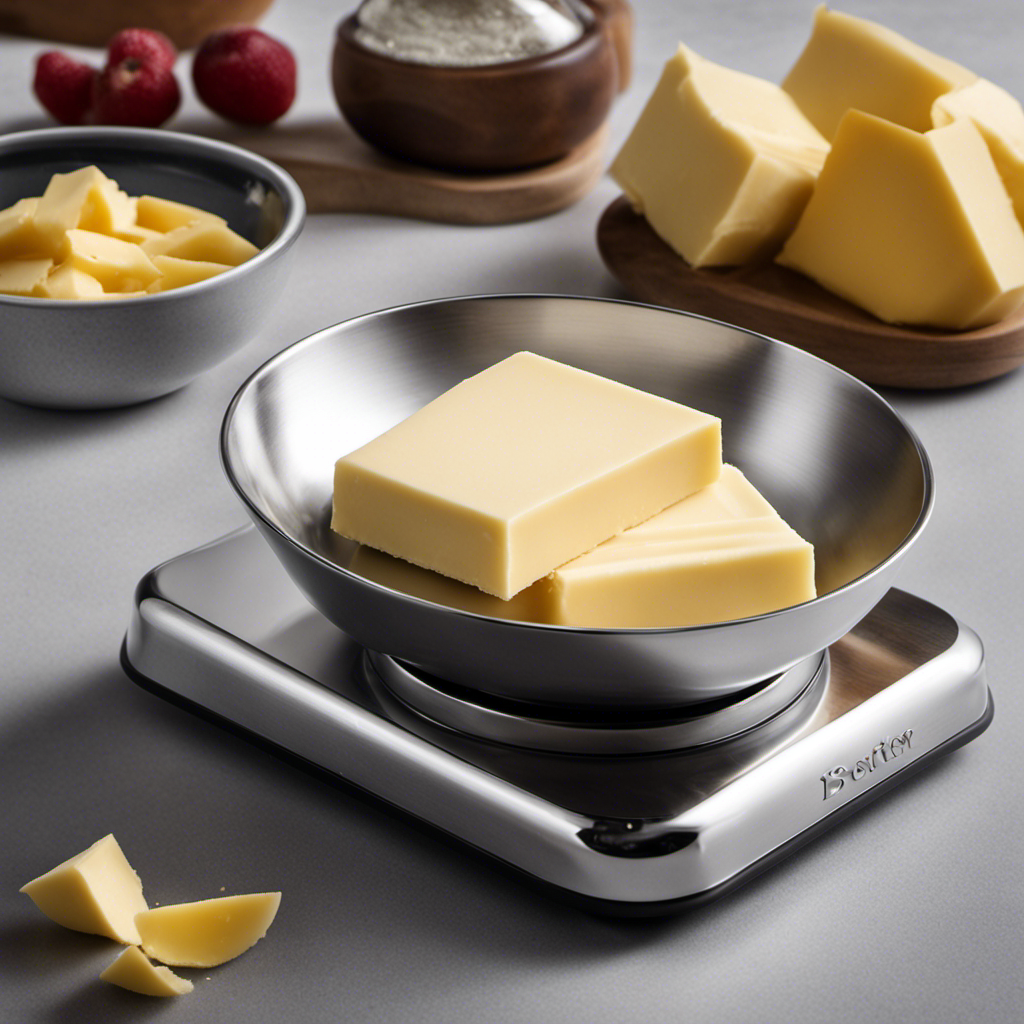
I frequently find myself in the kitchen, pondering over the amount of butter required for a recipe. It becomes particularly perplexing when the quantities are specified in grams.
So, let’s tackle that question head-on: how much is 115 grams of butter?
In this article, we’ll dive into the world of butter, exploring its origins, different types, and even how to measure it accurately.
By the end, you’ll have a clear understanding of just how much butter you need for your culinary adventures.
Key Takeaways
- 115 grams of butter is approximately equal to 1/2 cup.
- Accurate butter measurement is important for achieving desired results in recipes.
- Different types of butter have different flavor profiles and health benefits.
- Butter substitutes like vegan butter, applesauce, mashed bananas, or Greek yogurt can be used as alternatives.
The Origin of Butter
Butter is believed to have originated in ancient times. It was first made by separating the cream from milk and churning it until it formed a solid product. The invention of butter churns helped streamline the process, making it easier and faster to produce butter.
Butter has been a staple in many cultures throughout history, prized for its rich flavor and versatility in cooking. In terms of health benefits, butter contains essential vitamins such as A, D, E, and K, which are fat-soluble and play important roles in our overall health. Butter also provides a good source of healthy fats, which are necessary for the absorption of certain nutrients and the proper functioning of our body.
However, it’s important to consume butter in moderation as it is high in calories and saturated fats.
Different Types of Butter
When it comes to butter, there are several key points to consider.
Salted vs unsalted: Salted butter contains added salt for flavor, while unsalted butter is plain and allows for more control over the saltiness of a dish.
Spreadable or block: Spreadable butter is typically mixed with oil or other ingredients to make it easier to spread, while block butter is solid and often used for baking.
Cultured or regular: Cultured butter is made with live bacteria cultures, giving it a tangy flavor, while regular butter is made without these cultures.
Understanding these differences can help you choose the right type of butter for your cooking and baking needs.
Salted Vs Unsalted
To determine whether you prefer salted or unsalted butter, consider the flavor profile you desire in your dishes. Salted butter has a distinct savory taste due to the added salt, which can enhance the flavors of certain dishes. On the other hand, unsalted butter has a more neutral flavor, allowing the other ingredients in your dish to shine.
When it comes to health benefits, unsalted butter is often considered a healthier option. It contains no added salt, making it a better choice for individuals watching their sodium intake. Additionally, unsalted butter allows you to control the amount of salt in your recipes, giving you more control over your overall sodium consumption.
Spreadable or Block
Spreadable butter is a convenient option for those who prefer a softer texture for spreading on toast or bread. Unlike block butter, which can be hard and difficult to spread, spreadable butter is made by blending butter with vegetable oils or other fats. This process creates a smooth and spreadable consistency that is easier to use. However, it is important to note that spreadable butter generally contains a higher percentage of water compared to block butter. This can result in a lower fat content and potentially affect the taste and texture of baked goods. On the other hand, clarified butter, also known as ghee, is made by heating butter to remove the water and milk solids. This process results in a rich and nutty flavored fat with a higher smoke point, making it suitable for cooking at higher temperatures. While spreadable butter is great for everyday use, clarified butter is a versatile option for various culinary applications.
| Spreadable Butter | Clarified Butter |
|---|---|
| Softer texture | Rich and nutty |
| Easier to spread | Higher smoke point |
| Contains more water | Suitable for higher temperature cooking |
Cultured or Regular
Cultured butter has a tangy and complex flavor profile that sets it apart from regular butter. It is made by fermenting cream with live bacteria cultures, which gives it a distinct taste and aroma.
Cultural significance: Cultured butter has a rich history and cultural significance in many cuisines. It is often associated with European culinary traditions and is prized for its superior flavor and texture.
Nutritional differences: Cultured butter contains higher amounts of beneficial bacteria, such as Lactobacillus, which can support gut health. It also has lower levels of lactose, making it easier to digest for those with lactose intolerance. Additionally, it has a higher content of vitamins A, D, and E compared to regular butter.
Butter Conversion Chart
You can easily convert 115 grams of butter using a butter conversion chart.
When it comes to baking, butter is a staple ingredient that adds richness and flavor to your creations. While there are butter substitute options available, using real butter has its benefits.
Butter contains fat, which helps create a tender and moist texture in baked goods. It also adds a distinct buttery flavor that can’t be replicated.
When using a butter conversion chart, you can easily determine the equivalent amount of butter needed based on the recipe’s requirements. Whether it’s measuring out tablespoons or cups, the chart provides accurate measurements for a successful baking experience.
How to Measure Butter
When it comes to baking, accurate measurements are crucial for achieving the desired results. One common ingredient that can be tricky to measure is butter.
In this discussion, we will explore the importance of butter measurement conversions, the difference between weight and volume measurements, and tips for accurately measuring butter for your recipes.
Butter Measurement Conversions
There’s no need to worry about converting butter measurements if you use an online calculator. It’s a quick and easy way to get accurate measurements without the hassle of doing the math yourself.
But just in case you want to know some common butter measurement equivalents and substitutions, here are a few to keep in mind:
- 1 cup of butter is equal to 227 grams or 2 sticks.
- 1 tablespoon of butter is approximately 14 grams.
- If you need to substitute butter in a recipe, you can use equal parts of vegetable oil, coconut oil, or margarine.
Using these equivalents and substitutions, you can confidently bake and cook without worrying about getting the butter measurements just right. With the help of an online calculator, you’ll be able to convert any butter measurement with ease.
Weight Vs Volume
In the previous subtopic, we discussed measurement conversions for butter. Now, let’s dive into the concept of weight measurement and its relation to butter packaging.
Weight measurement is crucial when it comes to accurately packaging and labeling butter. Butter is typically sold in pre-packaged quantities, such as 250 grams or 1 pound. These measurements ensure consistency and convenience for consumers.
When packaging butter, manufacturers use precise weighing equipment to determine the weight of each package. This ensures that consumers receive the exact amount of butter they expect.
Accurate weight measurement is important not only for consumer satisfaction but also for regulatory compliance. Packaging laws regulate the accuracy of weight measurements to protect consumers from being deceived by misleading packaging.
Accurate Butter Measuring
Accurate measuring is essential to ensure consumers receive the correct amount of butter. When it comes to butter weight, measuring accuracy is crucial for both cooking and baking purposes. Here are some key points to consider:
-
Use a kitchen scale: A kitchen scale provides the most accurate measurements for butter weight, ensuring precision in your recipes.
-
Convert from volume to weight: Butter is often sold in sticks or cups, but these measurements can vary. To ensure accuracy, use conversion charts to determine the weight equivalent of your desired amount.
-
Consider the temperature: Butter weight can vary depending on its temperature, so it’s important to measure it when it’s at room temperature for consistency.
Accurate measuring ensures your recipes turn out just right.
Now, let’s explore the concept of butter equivalents and how they can simplify your cooking and baking endeavors.
Butter Equivalents
115 grams of butter is equivalent to approximately 1/2 cup. When it comes to baking or cooking, it is crucial to have accurate measurements. Understanding butter equivalents and butter measurement conversions is essential for achieving the desired results in your culinary endeavors.
In the world of butter, conversions are commonly used to ensure precise measurements. For instance, when a recipe calls for 1/2 cup of butter, you can easily substitute it with 115 grams. This conversion is based on the weight-to-volume ratio of butter.
However, it is vital to note that different brands and types of butter may have slight variations in density, so it’s always a good idea to double-check the specific conversion for the butter you are using.
Butter in Baking
When you’re baking, it’s important to understand how butter contributes to the texture and flavor of your creations. Butter is not just a fat, it also contains water and milk solids, which affect the structure and moisture content of baked goods.
Here are three ways butter impacts your baking:
-
Texture: Butter adds richness and tenderness to baked goods, creating a soft and crumbly texture.
-
Flavor: Butter provides a distinct and delicious flavor that enhances the taste of your baked treats.
-
Moisture: The water content in butter helps keep your baked goods moist and prevents them from drying out.
To ensure accurate butter measuring, use a kitchen scale for precise measurements. Soften butter to room temperature before measuring, and level it off using a knife for accuracy.
Now, let’s explore some butter substitutes that can be used in baking.
Butter Substitutes
If you’re looking for a healthier option, there are several butter substitutes that can be used in baking. Butter alternatives have become increasingly popular, especially among those following vegan or plant-based diets.
One of the most common butter substitutes is vegan butter, which is made from plant-based oils like coconut oil or avocado oil. Vegan butter options are usually free from dairy, cholesterol, and trans fats. They can be used in a 1:1 ratio as a direct replacement for butter in baking recipes.
Other butter alternatives include applesauce, mashed bananas, or Greek yogurt, which can add moisture and texture to baked goods.
Fun Facts About Butter
Butter is a versatile ingredient that has been used in cooking and baking for centuries. It not only adds richness and flavor to dishes but also provides several nutritional benefits. Here are some fun facts about butter:
- Butter is made from cream that is churned until the fat separates from the liquid, resulting in butter and buttermilk.
- Butter is a good source of fat-soluble vitamins like vitamin A, E, and K.
- Butter contains a small amount of butyric acid, which is believed to have anti-inflammatory properties.
In terms of nutritional value, butter is high in calories and saturated fat. However, it also provides essential fatty acids and is a good source of vitamin D. It is important to consume butter in moderation as part of a balanced diet.
Frequently Asked Questions
How Many Calories Are in 115 Grams of Butter?
There are approximately 816 calories in 115 grams of butter. The nutritional value of butter is high in saturated fat and calories, so it should be consumed in moderation for a balanced diet.
Can I Use Margarine as a Substitute for Butter in Baking?
Sure, margarine can be used as a substitute for butter in baking. However, there are pros and cons to consider. Margarine can affect the texture of baked goods, so it’s important to choose the right type for your recipe.
How Long Does Butter Stay Fresh in the Refrigerator?
To properly store butter in the refrigerator, keep it in an airtight container or wrapped tightly in foil. Check for any signs of mold, discoloration, or an off smell to determine if it has gone bad.
Is It Possible to Freeze Butter for Long-Term Storage?
Freezing butter for long-term storage is possible. It helps maintain its freshness and prevents spoilage. When thawing, leave it in the refrigerator overnight. 115 grams of butter is approximately 8 tablespoons.
Can I Use Clarified Butter Instead of Regular Butter in a Recipe?
Using clarified butter instead of regular butter in a recipe has its benefits. It has a higher smoke point, making it great for sautéing and frying. To make clarified butter at home, melt butter and skim off the milk solids.
Conclusion
In conclusion, after diving into the world of butter, I’ve realized that 115 grams of butter is truly a glorious amount. It has the power to transform a simple recipe into a masterpiece, adding richness and flavor that is unmatched.
Whether it’s spread on toast or used in baking, this amount of butter can make taste buds dance with delight.
So next time you’re in the kitchen, don’t underestimate the power of 115 grams of butter. It is truly a magical ingredient.
Diana’s meticulous nature and editorial prowess set the gold standard for our content. With over a decade in the culinary and publishing industries, her guidance ensures that every article perfectly blends information and entertainment. A culinary experimenter, Diana loves whipping up new butter-based concoctions in her kitchen.
Butter Tips and Tricks
How Much Butter is 50g? A Comprehensive Guide
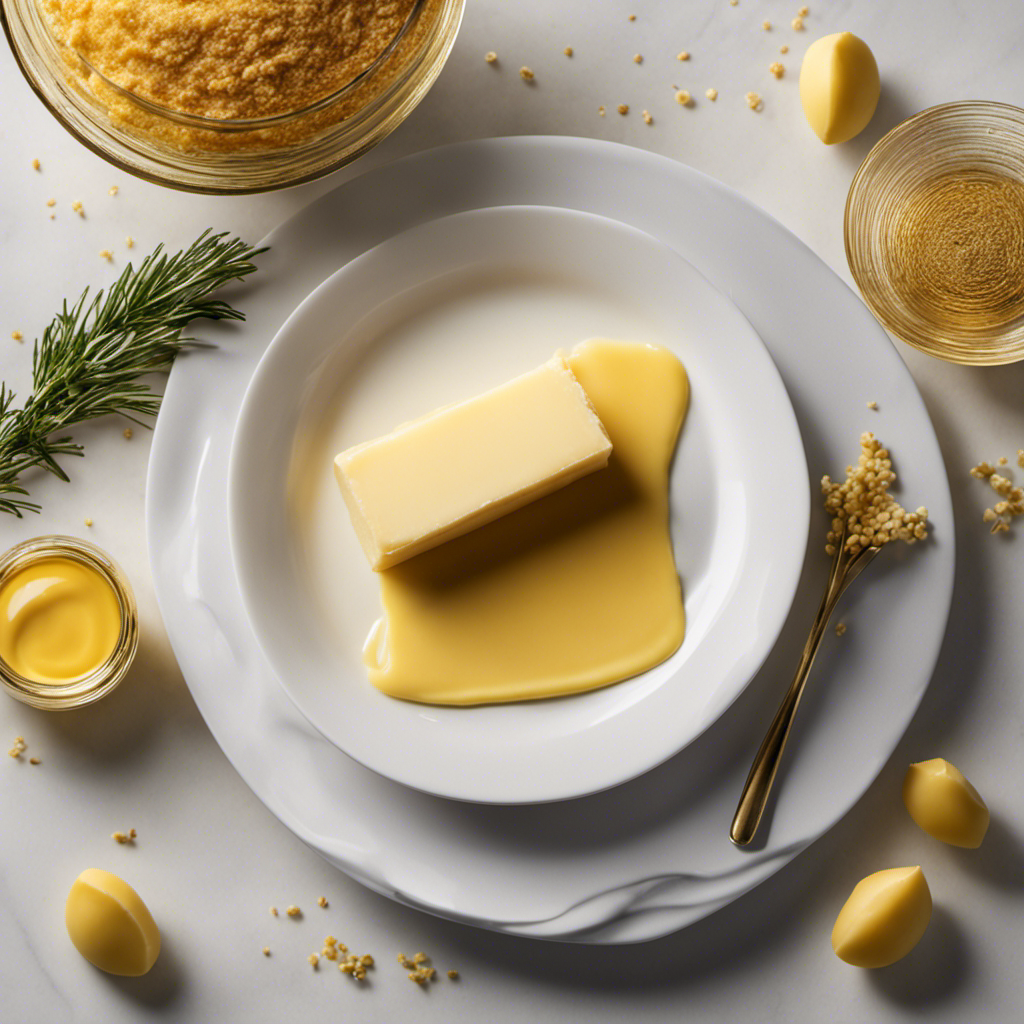
I’ve always been curious about the exact quantity of 50g of butter. This question is quite prevalent in the realm of cooking, and in this discussion, we will explore the accurate measurements and conversions associated with this specific quantity.
From ounces to cups, tablespoons to teaspoons, grams to kilograms, and even pounds to fluid ounces, we’ll cover it all. So, if you’ve ever found yourself unsure about the measurements of butter, look no further.
Let’s dive in and uncover the answers together.
Key Takeaways
- 50g of butter is approximately 1.76 ounces.
- 50g of butter is approximately 0.22 cups in the United States.
- 50g of butter is equivalent to approximately 3.5 tablespoons.
- 50g of butter is approximately 3.57 tablespoons or 50ml.
Different Units of Measurement for Butter
You’ll often find butter measured in grams, ounces, or cups depending on where you are. Converting butter from grams to pounds is a straightforward process. One pound is equal to approximately 454 grams, so to convert grams to pounds, you divide the number of grams by 454.
For example, if you have 500 grams of butter, you would divide 500 by 454 to get 1.1 pounds.
On the other hand, if you need to convert butter from ounces to tablespoons, it’s important to note that there are 2 tablespoons in 1 ounce. So, to convert ounces to tablespoons, you simply multiply the number of ounces by 2.
Now, let’s move on to converting 50g of butter to ounces.
Converting 50g of Butter to Ounces
When it comes to converting 50g of butter to ounces, it’s important to understand the precise measurements involved.
As a home cook, I often find myself needing to convert between different units of measurement, especially when following recipes from different sources.
In this discussion, I will delve into the details of converting 50g of butter to ounces, providing a clear and informative guide for fellow cooking enthusiasts.
Butter Weight Conversions
To convert 50g of butter, it’s helpful to know the appropriate weight conversions. Here are some butter weight equivalents and measurement conversions:
- 1 stick of butter: 113g
- 1 cup of butter: 227g
- 1 tablespoon of butter: 14g
Knowing these conversions can be useful when you come across a recipe that uses different measurements. For example, if a recipe calls for 100g of butter, you can easily determine that it is equivalent to approximately 0.88 sticks of butter or 0.44 cups.
Understanding butter weight equivalents allows you to accurately measure and convert butter quantities for cooking and baking. It ensures that you use the right amount of butter in your recipes, resulting in delicious and consistent outcomes.
Now that we have covered butter weight conversions, let’s move on to converting grams to ounces, which is another commonly used measurement in the culinary world.
50g to Ounces
Converting grams to ounces can be helpful when following recipes that use different measurement units.
When it comes to butter, the weight can vary depending on where you are. For example, in the United States, butter is typically sold in sticks, with each stick weighing 4 ounces or 113 grams.
So, if you need to convert 50 grams of butter to ounces, you would divide 50 by 28.35 (the number of grams in an ounce), which equals approximately 1.76 ounces.
In some European countries, butter is sold in 250-gram blocks, and in Australia, it’s commonly sold in 500-gram blocks. Therefore, it’s important to be aware of the butter weight in different countries when converting grams to ounces or pounds for your recipes.
Converting 50g of Butter to Cups
If you want to know how much 50g of butter is in cups, you can easily convert it. Butter measurements can vary between countries, so it’s important to understand the conversions.
Here’s how you can convert 50g of butter to cups:
-
First, convert grams to milligrams. Since 1 gram is equal to 1000 milligrams, 50g of butter is equal to 50,000 milligrams.
-
Next, compare butter measurements in different countries. In the United States, 1 cup of butter is equal to 227 grams. So, dividing 50,000 milligrams by 227 grams gives us approximately 0.22 cups of butter.
-
In Australia, 1 cup of butter is equal to 250 grams. Therefore, 50g of butter is approximately 0.2 cups in Australia.
-
In the United Kingdom, 1 cup of butter is equal to 227 grams as well. Hence, 50g of butter is roughly 0.22 cups in the UK.
Once you’ve converted 50g of butter to cups, you can easily transition to the subsequent section about converting 50g of butter to tablespoons.
Converting 50g of Butter to Tablespoons
When it comes to butter measurement conversions, understanding how to convert tablespoons to grams is essential.
In this discussion, I will explore the precise conversion ratio between tablespoons and grams for butter.
Butter Measurement Conversions
To measure 50g of butter, you’ll need a kitchen scale. Accurately measuring butter is crucial for achieving the desired results in baking and cooking.
Here is a butter conversion chart to help you measure butter accurately:
- 1 tablespoon of butter is equivalent to approximately 14 grams.
- 1 stick of butter is equal to 113 grams or 8 tablespoons.
- 1 cup of butter is equal to 227 grams or 2 sticks.
Using a kitchen scale ensures precise measurements, especially when dealing with small quantities of butter. It eliminates any guesswork and guarantees consistent results in your recipes.
Now that you know how to convert grams to tablespoons, let’s explore the conversion of tablespoons to grams for a more versatile approach to measuring butter.
Tablespoons to Grams
Remember, it’s important to accurately measure butter when converting tablespoons to grams for precise results in your recipes.
To convert tablespoons to grams, you need to know the density of the ingredient you are measuring. For butter, the general conversion is 1 tablespoon equals 14 grams. However, it’s always a good idea to check the specific conversion for the brand or type of butter you are using, as the density may vary slightly.
Additionally, if you need to convert grams to kilograms, simply divide the number of grams by 1000. This will give you the equivalent weight in kilograms.
Now that we have covered converting tablespoons to grams and grams to kilograms, let’s move on to the next section about converting 50g of butter to teaspoons.
Converting 50g of Butter to Teaspoons
Calculating conversions can be tricky, but did you know that 50g of butter is equivalent to approximately 3.5 tablespoons? When converting 50g of butter to tablespoons, it’s important to note that the density of butter can vary slightly depending on its temperature and brand. However, as a general rule, 1 tablespoon of butter weighs around 14 grams. Therefore, by dividing 50g by 14g, we can estimate that it is equal to approximately 3.57 tablespoons.
But what if you prefer to measure in milliliters instead of tablespoons? Converting 50g of butter to milliliters is a bit more straightforward. Since the density of butter is close to that of water, which is 1g/ml, we can assume that 50g of butter is roughly equal to 50ml. However, it’s always a good idea to double-check the specific conversion factor provided on the butter packaging to ensure accuracy.
Converting 50g of Butter to Sticks
When it comes to butter stick conversion, it’s important to understand the measurement equivalents for butter and how to convert grams to sticks.
The process may seem daunting at first, but with a little knowledge and practice, it becomes much simpler.
Butter Stick Conversion
To convert 50g of butter to butter sticks, you’ll need to know that one stick of butter is equal to 113g.
Here are some butter measurement tips and alternatives to butter sticks:
-
Butter Measurement Tips:
-
Use a kitchen scale for precise measurements.
-
If you don’t have a scale, 1 tablespoon of butter is roughly 14g.
-
Softened butter is easier to measure and mix, so leave it at room temperature for about 30 minutes before using.
-
Butter Stick Alternatives:
-
Margarine: A common substitute for butter, it has a similar texture and taste.
-
Coconut oil: It can be used in baking and cooking as a dairy-free alternative.
-
Vegetable shortening: Great for flaky pastries and pie crusts.
Remember to adjust the quantities accordingly when using these alternatives, as their moisture content and melting points may differ from butter sticks.
Measurement Equivalents for Butter
Remember, it’s helpful to know that one stick of butter is equivalent to 113 grams when measuring butter for your recipes. When it comes to butter measurement equivalents and butter weight conversions, precision is key.
It’s essential to have accurate measurements to ensure the success of your culinary endeavors. For instance, if a recipe calls for 50 grams of butter, you need to know precisely how much that is in terms of butter sticks or tablespoons. In this case, 50 grams of butter is approximately 0.44 sticks or 3.52 tablespoons.
Converting Grams to Sticks
If you want to convert grams to sticks, all you have to do is divide the number of grams by 113. This conversion is useful when working with recipes that require butter to be measured in sticks rather than grams.
Here are some additional conversions that may come in handy:
-
Converting grams to tablespoons:
-
Divide the number of grams by the density of the ingredient to get the volume in milliliters.
-
Convert milliliters to tablespoons using the conversion factor of 1 tablespoon = 14.79 milliliters.
-
Round the result to the nearest tablespoon.
-
Converting 50g of butter to pounds:
-
Divide the number of grams by 453.59237 to get the weight in pounds.
-
Round the result to the nearest hundredth of a pound.
Converting 50g of Butter to Milliliters
Converting 50g of butter to milliliters is simple. To convert grams to milliliters, you need to know the density of the substance, in this case, butter.
The density of butter is approximately 0.92 g/mL. Therefore, to convert 50g of butter to milliliters, you can use the formula:
Milliliters = Grams / Density
Plugging in the values, we get:
Milliliters = 50g / 0.92 g/mL
Simplifying, we find that 50g of butter is equal to approximately 54.35 mL.
Now, if you want to convert 50g of butter to tablespoons, you need to know that 1 tablespoon is equal to approximately 14.79mL.
Dividing 54.35 mL by 14.79 mL/tablespoon, we find that 50g of butter is equal to approximately 3.68 tablespoons.
Similarly, if you want to convert 50g of butter to cups, you need to know that 1 cup is equal to approximately 237 mL.
Dividing 54.35 mL by 237 mL/cup, we find that 50g of butter is equal to approximately 0.23 cups.
Converting 50g of Butter to Grams
In the previous subtopic, I discussed how to convert 50g of butter to milliliters. Now, let’s focus on converting 50g of butter to grams.
This conversion is straightforward, as grams is the standard unit for measuring butter. To convert 50g of butter to grams, you simply keep the value the same, as 50g is already in grams. So, 50g of butter is equal to 50 grams.
To provide further information on butter measurement equivalents, here are some useful conversions:
- 1 tablespoon of butter is equal to 14.2 grams.
- 1 stick of butter is equal to 113.4 grams or 8 tablespoons.
- 1 cup of butter is equal to 226.8 grams or 2 sticks.
These conversions can be handy when following recipes or adjusting butter quantities in your culinary endeavors.
Converting 50g of Butter to Kilograms
To convert 50 grams of butter to kilograms, simply divide the value by 1000, giving you 0.05 kilograms.
Converting grams to kilograms is a straightforward process that involves dividing the gram value by 1000. This conversion is necessary when dealing with larger quantities or when using the metric system.
Kilograms are a unit of mass commonly used in scientific and everyday contexts, providing a more practical measurement for larger quantities.
It is important to note that converting grams to kilograms is not the same as converting grams to pounds. To convert grams to pounds, you must divide the gram value by 453.59237, which is the conversion factor between the two units.
Therefore, if you want to convert 50 grams of butter to pounds, the result would be approximately 0.11 pounds.
Converting 50g of Butter to Pounds
To convert 50 grams of butter to pounds, you’ll need to divide the gram value by 453.59237. So, 50g of butter is equal to approximately 0.11023113 pounds.
When it comes to measuring butter, different units of measurement are used around the world. Here are three common units used for measuring butter:
-
Grams (g): This is the most common unit of measurement for butter. It is used in most recipes and is the easiest to convert to other units.
-
Kilograms (kg): This unit is used when larger quantities of butter are needed, such as in commercial kitchens or bakeries. To convert grams to kilograms, divide the gram value by 1000.
-
Pounds (lb): In the United States, butter is often measured in pounds. To convert grams to pounds, divide the gram value by 453.59237.
Converting between these different units can be useful when following recipes from different regions or when scaling up or down a recipe.
Converting 50g of Butter to Fluid Ounces
You can convert 50 grams of butter to fluid ounces by dividing the gram value by 28.35. To convert 50g of butter to milliliters, you can use the same conversion factor.
Since 1 fluid ounce is equivalent to 29.57 milliliters, dividing 50g by 28.35 will give you the approximate amount of butter in fluid ounces, which you can then multiply by 29.57 to get the equivalent in milliliters.
It is important to note that different brands of butter may have slightly different densities, which can affect the conversion. So, if you are comparing different brands of butter, it is advisable to check the specific density or weight-to-volume conversion factor provided by the manufacturer to ensure accuracy in your conversions.
Frequently Asked Questions
What Are Some Alternative Units of Measurement for Butter Besides Grams?
There are several alternative units of measurement for butter besides grams. One commonly used unit is ounces. To convert grams to ounces, you can divide the amount in grams by 28.35.
How Do You Convert 50g of Butter to Ounces?
Converting grams to ounces is not the same for all ingredients. When it comes to butter, the conversion may differ depending on whether it is salted or unsalted.
How Do You Convert 50g of Butter to Cups?
To convert 50g of butter to cups, you can use the conversion formula that states 1 cup is approximately equal to 226.8g of butter. Therefore, 50g of butter is approximately 0.22 cups.
How Do You Convert 50g of Butter to Tablespoons?
Converting grams of butter to tablespoons depends on the density of the butter. There is no standard conversion ratio, as different brands have varying densities. To be accurate and convenient, it’s best to use a kitchen scale for precise measurements.
How Do You Convert 50g of Butter to Teaspoons?
To convert 50g of butter to teaspoons, I would first measure it without using a scale by using tablespoon measurements. Common recipes that use 50g of butter include cookies, cakes, and pastries.
Conclusion
In conclusion, 50g of butter is equivalent to 1.76 ounces, approximately 0.22 cups, 3.53 tablespoons, 10.58 teaspoons, and 50 grams.
It is also equal to 0.05 kilograms, 0.11 pounds, and 1.76 fluid ounces.
These conversions provide a clear picture of the various units of measurement for butter, allowing for precise and accurate measurements in cooking and baking.
So next time you need to measure out 50g of butter, you’ll have a visual representation of its measurements in different units.
Sunny’s articles radiate enthusiasm, much like her sunny disposition. As our resident “Butter Geek”, she delves deep into the latest butter trends, ensuring our readers are always in the know. Beyond her writing, Sunny’s passion lies in exploring vegan butter alternatives and hosting butter-tasting soirées.
Butter Tips and Tricks
Quick Guide: How Much Butter is in a Pat?

As someone who passionately enjoys butter, I frequently catch myself contemplating the timeless inquiry: what exactly constitutes a pat of butter?
Join me on a journey through the history, sizes, and measurements of these delightful little pats.
We’ll explore the different cultures that have embraced this buttery tradition and discover the subtle differences between butter pats and butter dishes.
Get ready to be inspired by creative ways to serve and even decorate with butter pats.
Let’s dive into the world of butter and unravel the mystery of the perfect pat.
Key Takeaways
- The standard size for a pat of butter is about 1 tablespoon or 1/2 ounce.
- Butter pats come in different sizes, but there is a standard weight of approximately 1 tablespoon or 14 grams.
- Understanding butter pat measurements is essential for precise cooking and baking.
- Standardization in butter weight ensures consistent results in taste and texture, recipe accuracy and reproducibility, professional standards in culinary establishments, and time and cost efficiency in planning and inventory management.
The History of the Pat of Butter
You might be surprised to learn that the history of the pat of butter dates back centuries. Butter pats have been used for generations to serve butter in a convenient and elegant manner.
The origins of butter pats can be traced back to ancient civilizations, where butter was a staple in many cultures. In fact, the cultural significance of butter pats can be seen in various traditions and rituals.
In some cultures, the shape and design of the butter pat symbolize prosperity and abundance. Additionally, butter pats have been used as a form of artistic expression, with intricate designs and patterns carved into them.
Today, the tradition of using butter pats continues, adding a touch of elegance to any dining experience.
Different Types of Butter Pats
There are various types of butter pats available for you to choose from. When it comes to butter pat alternatives, you have a few options.
One popular alternative is using a butter dish. This allows you to store the butter and easily spread it onto your bread or toast without the need for individual pats.
Another option is using a butter bell, which keeps the butter fresh and spreadable by storing it upside down in water. This method can be quite effective in preserving the flavor and texture of the butter.
When it comes to butter pat storage, it’s important to keep them in a cool, dry place to prevent them from melting or becoming too soft. It’s also a good idea to store them in an airtight container to maintain their freshness.
Butter Pat Sizes and Measurements
One popular option for storing and spreading butter without individual pats is using a butter dish.
As someone who has spent years working in the culinary industry, I have learned a thing or two about measuring butter portions and butter presentation techniques.
Here are four key points to consider when it comes to butter pat sizes and measurements:
-
Standard Butter Pat: The most common size for a pat of butter is about 1 tablespoon or 1/2 ounce. This is usually the amount served with a single slice of bread or a muffin.
-
Mini Butter Pat: For smaller portions or delicate pastries, a mini butter pat is ideal. These are typically about half the size of a standard pat, measuring around 1/2 tablespoon or 1/4 ounce.
-
Shaped Butter Pat: To add a touch of elegance to your butter presentation, consider shaping your butter pats into decorative shapes. Use a butter mold or simply mold it by hand into a desired shape.
-
Butter Spreader: When serving butter at a buffet or for a large gathering, using a butter spreader can make it easier for guests to serve themselves. These spreaders are typically wider and flatter than a regular butter knife, allowing for smoother spreading.
How Much Butter in a Pat
When it comes to butter pat sizes and measuring butter portions, I can confidently say that I’ve learned a thing or two.
Over the years, I’ve experimented with different sizes and measurements to find the perfect balance of flavor and convenience.
In this discussion, I’ll share my knowledge and experiences to help you navigate the world of butter pats and ensure you have just the right amount for your culinary endeavors.
Butter Pat Size
The size of a pat of butter varies depending on the brand and the intended use. As someone who has been in the culinary industry for years, I have come across countless variations of butter portion control.
Here are four common measurements used to measure butter:
-
One pat of butter typically equals one tablespoon or 14 grams. This is a standard measurement used in many recipes.
-
Some brands sell individual pats of butter that are smaller, around half a tablespoon or 7 grams. These are convenient for portion control or for spreading on individual slices of bread.
-
In restaurants or bakeries, you might come across larger pats of butter, which can be up to two tablespoons or 28 grams. These are often used for cooking or baking purposes.
-
Lastly, for those watching their calorie intake, you can find reduced-fat butter pats. These are smaller in size, usually around 10 grams or three-quarters of a tablespoon.
Understanding the various measurements of a pat of butter is essential for precise baking and cooking. It allows for better control over the amount of butter used, ensuring consistent results in your dishes.
Measuring Butter Portions
To accurately measure portions of butter, it’s important to be aware of the various sizes available and their intended uses. When it comes to butter portion sizes, there are a few common measurements that you’ll often come across.
The most common sizes include tablespoons, teaspoons, and ounces. These measurements can be used for different purposes, whether you’re baking, cooking, or simply spreading butter on toast. Measuring butter portions allows for consistency in recipes and ensures that you’re using the right amount of fat in your dishes. It’s also helpful for portion control if you’re trying to watch your calorie intake.
Understanding the different sizes and how to measure them accurately is essential for achieving the desired results in your culinary endeavors. Now, let’s delve into the standard weight of a butter pat.
The Standard Weight of a Butter Pat
When it comes to butter pats, the size can vary, but there is a standard weight that is generally followed. However, it is important to note that there may be slight weight variations in butter due to factors such as moisture content and manufacturing processes.
Standardization of butter pat size and weight is crucial for consistent measurements and portion control, especially in professional culinary settings where accuracy is key.
Butter Pat Size
Butter pats come in varying sizes depending on the brand and intended use. Here are four common sizes you may encounter:
-
Standard Size: The most common butter pat size measures approximately 1 tablespoon or 14 grams. This size is typically used for spreading on toast or adding to recipes.
-
Mini Size: Smaller butter pats, around half the size of the standard, are often used for individual servings. They are perfect for buttering a single piece of bread or adding to a small dish.
-
Jumbo Size: On the other end of the spectrum, jumbo butter pats can be two to three times the size of a standard pat. These larger pats are often used for baking or cooking purposes, where a larger amount of butter is needed.
-
Custom Sizes: Some brands offer butter pats in custom sizes, catering to specific needs or preferences. These may include extra small or extra large options to suit different requirements.
Understanding butter pat sizes and measurements is essential for achieving the desired results in your culinary creations. As an experienced chef, I have come across different measurements for butter pats in my culinary journey.
Weight Variations in Butter
For optimal cooking results, it’s important to be aware of the weight variations in different types of butter. As an experienced chef, I know that the weight of a pat of butter can vary depending on the brand and type of butter you use. To give you a better understanding, here is a table showing the weight variations in butter:
| Type of Butter | Weight per Pat (in grams) |
|---|---|
| Salted | 7 |
| Unsalted | 8 |
| European | 10 |
| Whipped | 5 |
Knowing the weight of a pat of butter is essential when following a recipe. It ensures that you are using the right amount of fat in your dishes and helps achieve the desired texture and flavor. Additionally, understanding the weight variations can also impact the cost of a pat of butter. Some brands may offer smaller or larger pats, which can affect the overall price. So, always check the weight when purchasing butter for your culinary endeavors.
Importance of Standardization?
To ensure consistency in your cooking, it’s crucial to understand the importance of standardization in the weight of different types of butter. Standardization plays a significant role in the culinary arts, impacting the final outcome of your dishes. Here are four reasons why standardization is essential:
-
Consistent Results: When you use standardized measurements for butter, you can achieve the same taste and texture every time you cook. This consistency is vital for recipes that rely on the precise balance of ingredients.
-
Recipe Accuracy: Standardizing the weight of butter ensures that recipes are accurate and reproducible. This allows chefs and home cooks alike to follow instructions precisely and achieve the desired results.
-
Professional Standards: Standardization is crucial in professional kitchens, where consistency is key. By adhering to standardized measurements, chefs can maintain the quality and reputation of their establishments.
-
Time and Cost Efficiency: Standardization allows for efficient planning and inventory management. By knowing the exact weight of butter, chefs can calculate costs accurately and avoid waste.
The Cost of a Pat of Butter
Did you know that a pat of butter can cost anywhere from 50 cents to a dollar? As an experienced chef, I understand the importance of finding cost-effective alternatives for butter portions in the culinary arts. While butter pats are a classic choice, they can be quite expensive, especially when used in large quantities. To address this issue, I have compiled a table below comparing the cost and alternatives for butter portions:
| Option | Cost per portion | Benefits |
|---|---|---|
| Butter pats | $0.50 – $1.00 | Traditional, easy to use |
| Butter sticks | $0.30 – $0.50 | Convenient, easily measured |
| Margarine | $0.20 – $0.30 | Lower cost, similar taste |
As you can see, there are alternatives to butter pats that can help reduce costs without compromising on taste or functionality. Transitioning now to the subsequent section, let’s explore the importance of butter pats in the culinary arts.
The Importance of Butter Pats in Culinary Arts
As a seasoned chef, I’ve learned the importance of butter presentation techniques. I’ve mastered the art of creating beautifully sculpted butter pats that enhance the visual appeal of any dish.
In addition to aesthetics, butter portion control is crucial. It helps maintain consistency and balance in recipes, allowing for precise measurements and ensuring the desired flavor profile.
Furthermore, understanding the impact of butter on taste is essential. Butter has the ability to enhance and accentuate the flavors of other ingredients. This knowledge is key in creating well-rounded and flavorful dishes.
Butter Presentation Techniques
Butter can be shaped into various forms to enhance its presentation. As a culinary expert, I understand the importance of butter presentation techniques and the role butter pats play in the world of culinary arts. Here are four techniques that can elevate the visual appeal of butter:
-
Butter curls: Using a butter curler, create delicate, spiral-shaped curls that add an elegant touch to any dish.
-
Butter rosettes: Using a piping bag fitted with a star tip, pipe small rosettes of butter onto a serving plate for a sophisticated look.
-
Butter molds: Use decorative butter molds to shape butter into intricate designs or patterns, perfect for special occasions or high-end dining experiences.
-
Butter stamps: Press a unique design onto a pat of butter using a butter stamp, leaving an imprint that adds a personal touch to your presentation.
By mastering these butter presentation techniques, chefs can elevate their dishes and create a visually stunning experience for diners.
Now, let’s delve into the importance of butter portion control.
Butter Portion Control
Mastering portion control is crucial in ensuring that the right amount of butter is used in each dish. Not only does it help maintain the balance of flavors, but it also promotes a healthier lifestyle. As an experienced chef, I can attest to the benefits of portion control when it comes to butter. By using the perfect amount, you can enhance the taste of your dishes without overwhelming them with excessive fat. To help you visualize the importance of portion control, take a look at the table below:
| Dish | Butter Pat |
|---|---|
| Toast | 1/2 teaspoon |
| Pancake | 1 teaspoon |
| Baked Potatoes | 1 tablespoon |
Butter’s Impact on Taste
Using the right amount of butter can significantly enhance the taste of your dishes. As someone who has spent years in the kitchen experimenting with different ingredients, I can confidently say that butter plays a crucial role in creating mouth-watering flavors. Here’s why:
-
Creaminess: Butter’s texture adds a luxurious creaminess to sauces, soups, and baked goods, making them more indulgent and satisfying.
-
Flavor enhancer: The richness of butter amplifies the natural flavors of ingredients, making every bite burst with deliciousness.
-
Moisture retention: In baking, butter helps to lock in moisture, resulting in moist and tender cakes, cookies, and pastries.
-
Browning agent: Butter’s high fat content promotes browning, creating a beautiful golden crust on breads and pastries, adding depth and complexity to their taste.
Now, let’s explore how the use of butter pats differs in various culinary traditions around the world.
Butter Pats in Different Cultures
In different cultures, people have various ways of enjoying their meals with a pat of butter. The history of butter pats dates back centuries and holds significant cultural significance.
Butter pats were traditionally used to measure the amount of butter served at a meal, ensuring equal portions for everyone. This practice reflects the importance of fairness and communal dining in many cultures.
Additionally, butter pats have been used as a way of enhancing the flavor of dishes. The simple act of placing a pat of butter on top of warm bread or vegetables adds richness and depth to the overall taste.
From European cuisine to American Southern cooking, the use of butter pats has become ingrained in culinary traditions, symbolizing not only a delicious addition to a meal but also a connection to heritage and tradition.
Butter Pats Vs. Butter Dishes: What’s the Difference
Butter pats and butter dishes have distinct differences that you should be aware of. As an experienced butter enthusiast, I have learned the importance of understanding the nuances of butter serving. Here are four key differences between butter pats and butter dishes:
-
Size: A butter pat is a small, individual portion of butter, typically weighing around one tablespoon. On the other hand, a butter dish is a larger container that holds a whole stick of butter.
-
Presentation: Butter pats are usually served individually on small plates or placed directly on a dinner roll. They add a touch of elegance to a dining experience. In contrast, butter dishes are designed to hold the whole stick of butter and are often placed on a table for self-service.
-
Etiquette: When using butter pats, it is important to use a butter knife to transfer the butter from the pat to your bread or roll. This ensures proper hygiene and prevents any cross-contamination. With butter dishes, guests can use a communal butter knife to spread the butter onto their own bread.
-
Alternatives: If butter pats are not available, you can use alternative serving options such as small butter bells or butter molds. These alternatives provide a similar individual serving experience while adding a unique touch to your table setting.
Creative Ways to Serve Butter Pats
As a seasoned butter enthusiast, I am always on the lookout for creative ways to serve butter pats. Not only do they add a touch of elegance to any dining table, but they can also be used as a canvas for artistic expression. One of my favorite ways to showcase butter pats is by crafting them into intricate designs. From delicate flowers to whimsical animals, the possibilities are endless. I have even seen butter pat sculptures that resemble famous landmarks! To give you some inspiration, here is a table showcasing a few of my favorite butter pat crafts:
| Design | Description | Difficulty Level |
|---|---|---|
| Flower | A dainty blossom | Easy |
| Butterfly | Graceful and airy | Moderate |
| Eiffel Tower | An iconic landmark | Challenging |
| Heart | Symbol of love | Easy |
| Dolphin | Playful and fun | Moderate |
Now that you have some ideas, let’s explore how butter pats can be used as a decorative element in dining settings.
Butter Pats as a Decorative Element in Dining Settings
You can elevate the visual appeal of your dining table by incorporating butter pats as a tasteful decorative element. Not only do they add an elegant touch, but they also serve as a practical way to present butter to your guests.
Here are four alternatives to traditional butter pats that can enhance your dining experience:
-
Customized Butter Pats: Personalize your butter pats by having them engraved with your initials or a design that complements your table setting.
-
Ceramic Butter Dishes: Instead of using individual pats, opt for a beautiful ceramic butter dish that can hold a block of butter, adding a touch of sophistication to your table.
-
Butter Knives: Use decorative butter knives with intricate designs or embellishments to enhance the overall aesthetic of your dining table.
-
Butter Molds: Create unique and eye-catching shapes by using butter molds. From flowers to animals, these molds can add a whimsical touch to your table.
When incorporating butter pats into your dining setting, it is important to follow butter pat etiquette. Place them to the left of each place setting, alongside the bread plate, and always use a clean butter knife when serving.
Frequently Asked Questions
How Is Butter Made?
Butter is made by churning cream until the fat molecules stick together, forming a solid mass. There are various butter production techniques, including traditional methods and industrial processes. Different types of butter can be made by adjusting the fat content or adding flavorings.
What Is the Nutritional Value of a Pat of Butter?
The nutritional benefits of a pat of butter are rich in calories, fat, and vitamins A and D. The recommended serving size is about one tablespoon, which can add flavor and richness to meals.
Can Butter Pats Be Used for Purposes Other Than Serving Butter?
Butter pats can be used for more than just serving butter. I know from my experience that they can be used for crafts like butter pat art or as alternatives for holding small portions of condiments.
Are There Any Health Concerns Associated With Consuming Butter Pats?
Health concerns associated with consuming butter pats include high saturated fat content. However, moderation is key, and incorporating them into a balanced diet can provide some health benefits. Alternatives to butter pats include spreads made from nuts or avocado.
How Long Can a Pat of Butter Be Stored Before It Goes Bad?
When it comes to storing butter pats, proper storage is key. I’ve found that if stored in the fridge, they can last for quite a while, ensuring their longevity and freshness.
Conclusion
After diving into the fascinating world of butter pats, it’s clear that these small yet mighty components of dining settings have a rich history and cultural significance.
From their humble beginnings to their various shapes and sizes, butter pats have stood the test of time. They may seem like a simple accessory, but they have the power to elevate any dining experience.
So next time you sit down for a meal, remember the butter pat and its ability to spread joy like a warm ray of sunshine on a cool morning.
Sunny’s articles radiate enthusiasm, much like her sunny disposition. As our resident “Butter Geek”, she delves deep into the latest butter trends, ensuring our readers are always in the know. Beyond her writing, Sunny’s passion lies in exploring vegan butter alternatives and hosting butter-tasting soirées.
-
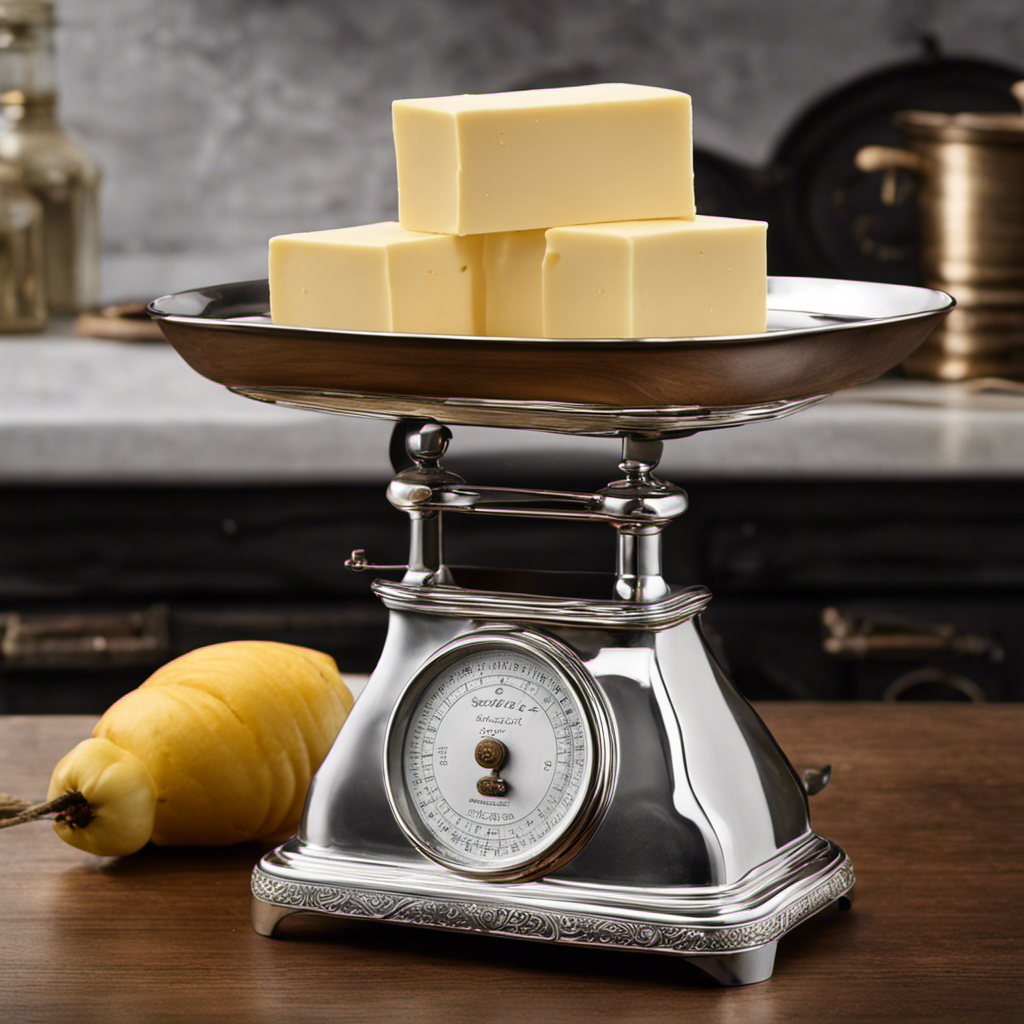
 Butter Tips and Tricks2 weeks ago
Butter Tips and Tricks2 weeks agoConverting 3/4 Cup of Butter to Sticks: How Many Sticks?
-
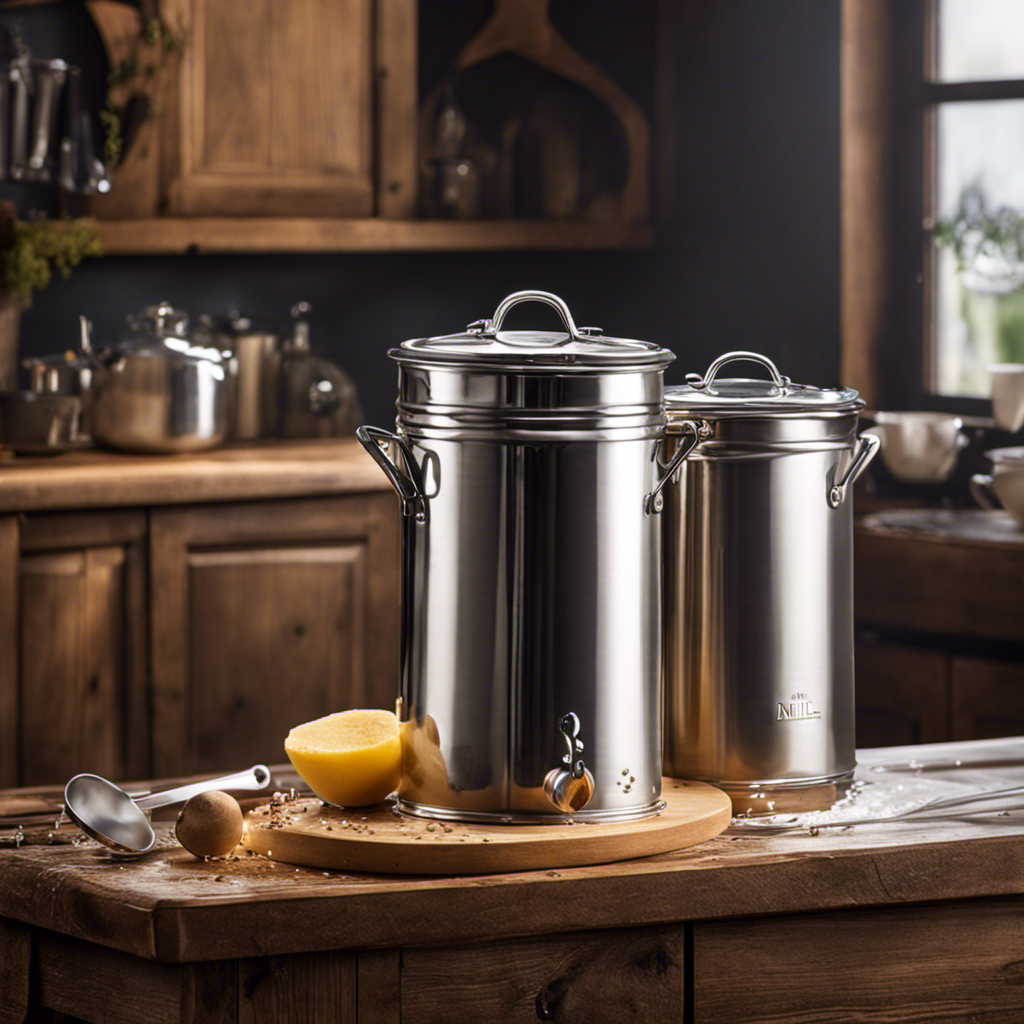
 Recipes & Culinary Uses3 months ago
Recipes & Culinary Uses3 months agoHomemade Butter Making at Home with Fresh Milk
-
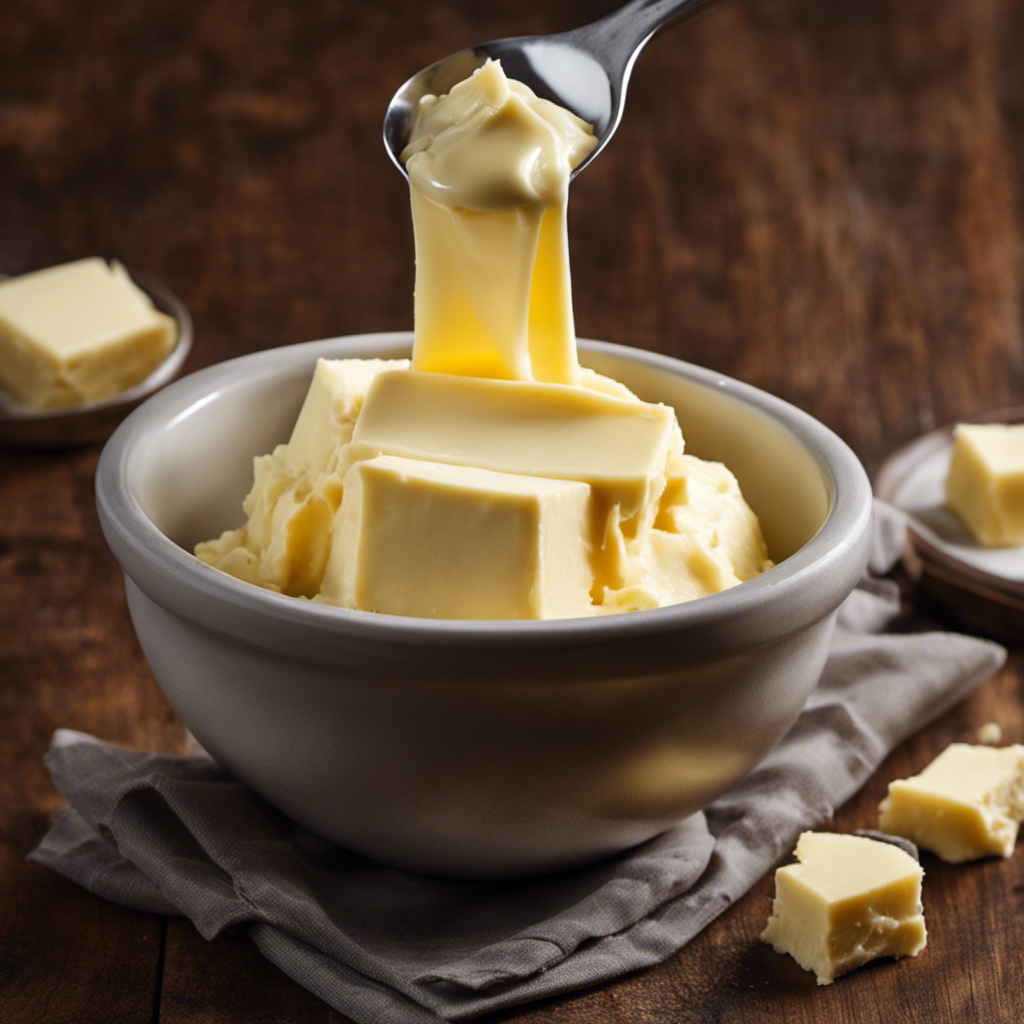
 Butter Tips and Tricks6 days ago
Butter Tips and Tricks6 days agoHow Many Tablespoons of Butter Are in 3/4 Cup?
-

 Recipes & Culinary Uses3 months ago
Recipes & Culinary Uses3 months ago10 Steps to Cook Delicious Dried Butter Beans
-
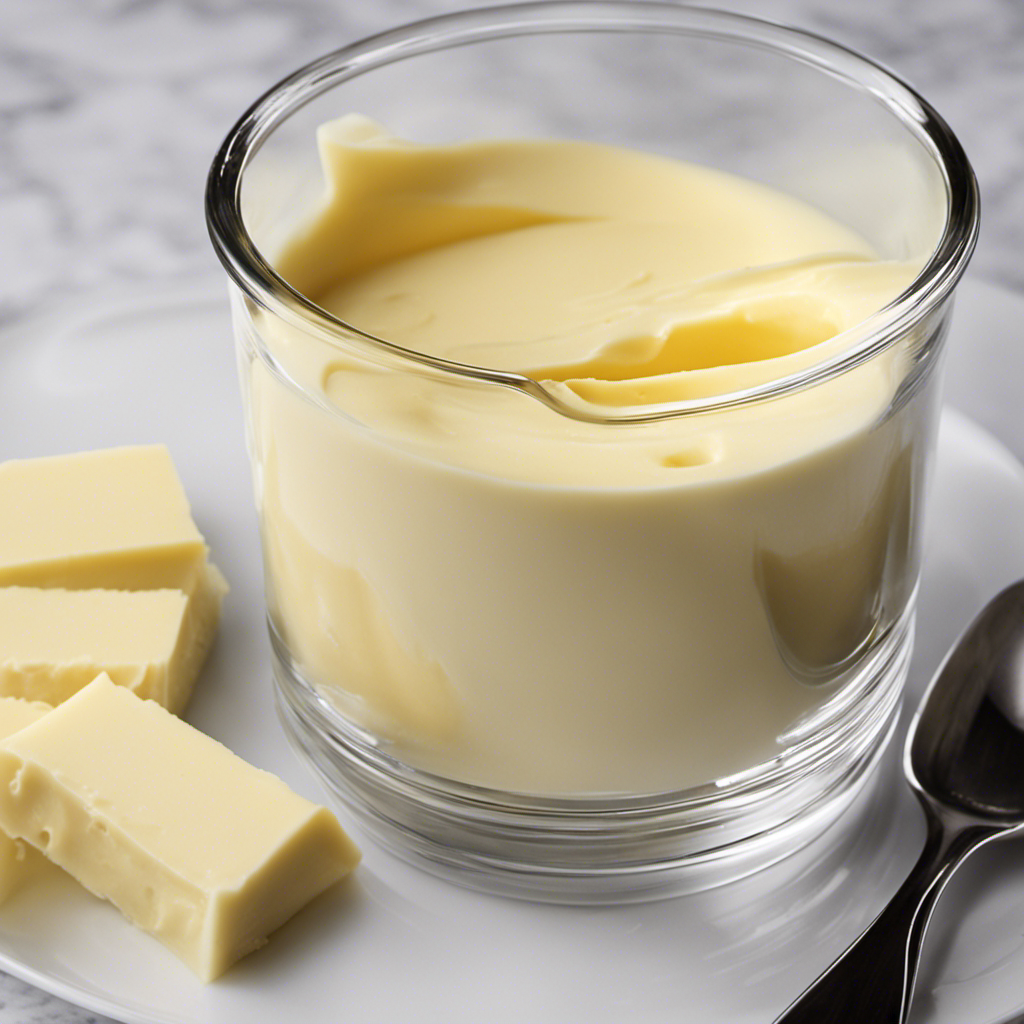
 Recipes & Culinary Uses3 months ago
Recipes & Culinary Uses3 months agoHow Many Tablespoons of Butter in 3/4 Cup: A Simple Guide
-
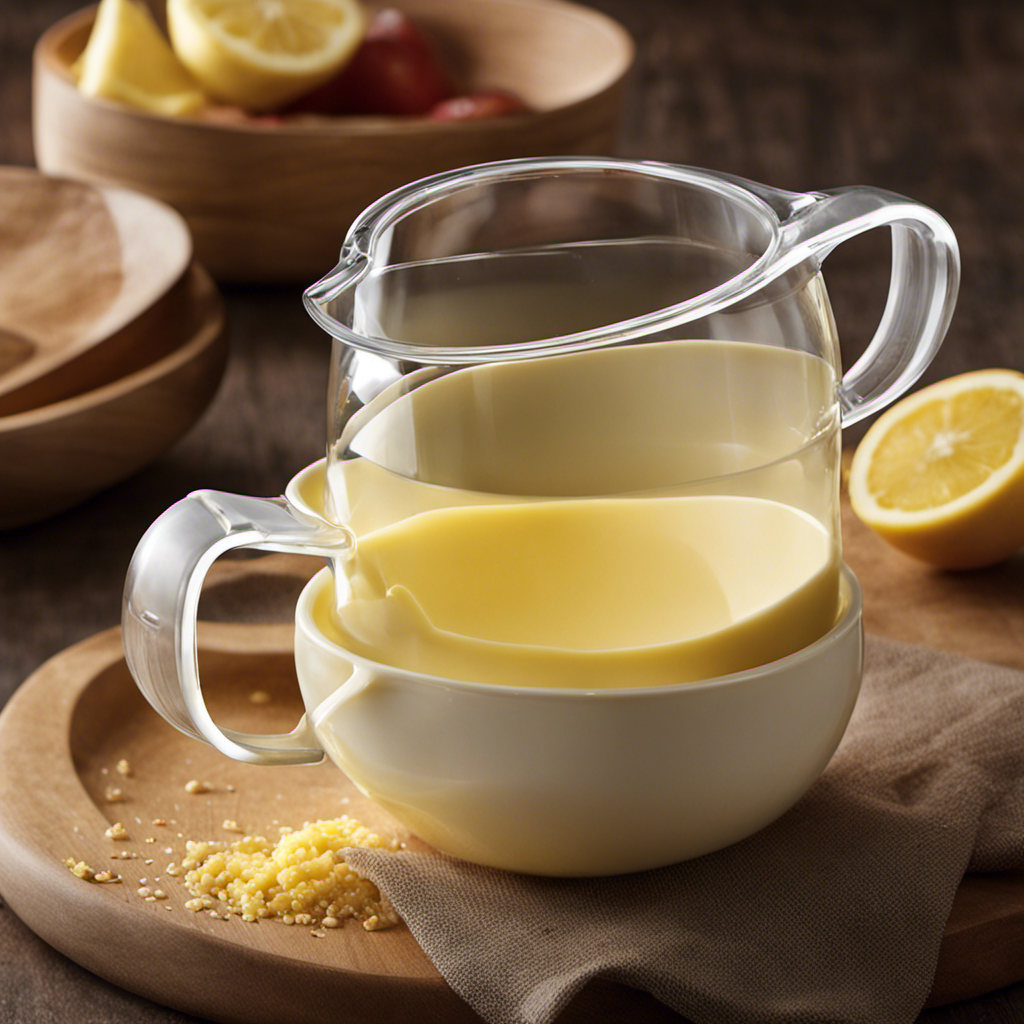
 Butter Tips and Tricks7 days ago
Butter Tips and Tricks7 days agoHow Many Tablespoons of Butter in 1/3 Cup: A Simple Guide
-

 Recipes & Culinary Uses3 months ago
Recipes & Culinary Uses3 months agoHow Many Sticks of Butter Equals a Pound: A Handy Guide
-

 Recipes & Culinary Uses2 months ago
Recipes & Culinary Uses2 months agoCreate Butter From Whole Milk in 7 Simple Steps








